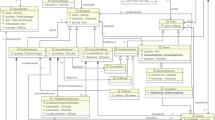Abstract
Performance evaluation plays an important role in system analysis. A compositional approach to model and evaluate content adaptation systems is presented in this paper, using the high-level system description and modelling language PEPA. Three computational methods, i.e. solving generator, stochastic simulation and fluid approximation, are demonstrated to derive performance measures from the PEPA model of content adaptation systems. A comprehensive comparison between these three computational methods shows that solving generator is only feasible for evaluating small scale systems, while for large scale systems the other two approaches are effective and promising. The simulation can achieve a high accuracy at high computational costs, while the fluid approximation approach can obtain an acceptable accuracy at a low cost. The consistence between the latter two computational methods is also studied.







Similar content being viewed by others
Notes
This kind of scenario or population is determined by the starting state of the PEPA model, which is the same as the starting states of the corresponding concentrated density dependent CTMCs.
References
Hillston, J. (1996). A compositional approach to performance modelling. Cambridge University Press. PhD Thesis.
Ding, J., Hillston, J., & Laurenson, D. (2009). Performance modelling of content adaptation for a personal distributed environment. Wireless Personal Communications, 48, 93–112.
Attou, A., Ding, J., Laurenson, D., & Moessner, K. (2008). Performance modelling and evaluation of an adaptation management system. In Inernational symposium on performance evaluation of computer and telecommunication systems (SPECTS 2008) (Edinburgh, Scotland).
Ding, J., Hillston, J., & Laurenson, D. (2010). Evaluating the response time of large scale content adaptation systems using peformance evaluation process algebra. In Proceedings of IEEE international communications conference 2010 (ICC’10), (Cape Town, South Africa).
Ding, J., Zhu, X.-S., & Li, B. (2012). A performance evaluation process algebra-based fluid approximation approach to evaluate large scale content adaptation systems. Sensor Letters, 10(8), 1698–1707.
Hillston, J. (2005). Fluid flow approximation of PEPA models. In International conference on the quantitative evaluation of systems (QEST’05), IEEE Computer Society.
Tribastone, M., Gilmore, S., & Hillston, J. (2012). Scalable differential analysis of process algebra models. IEEE Transactions on Software Engineering, 38(1), 205–219.
Ding, J. (2010). Structural and fluid analysis of large scale PEPA models—with applications to content adaptation systems. PhD Thesis, The Univeristy of Edinburgh. http://www.dcs.ed.ac.uk/pepa/jie-ding-thesis.pdf.
Ding, J., & Hillston, J. (2010). Fundamental results of fluid approximations of PEPA models. http://arxiv.org/abs/1008.4754.
Tribastone, M., Ding, J., Gilmore, S., & Hillston, J. (2012). Fluid rewards for a stochastic process algebra. IEEE Transactions on Software Engineering, 38(4), 861–874.
Canali, C., Cardellini, V., & Colajanni, M. (2005). Performance comparison of distributed architectures for content adaptation and delivery of web resources. In Proc. of the international workshop on services and infrastructure for the ubiquitous and mobile internet (SIUMI’05).
Canali, C., Cardellini, V., & Colajanni, M. (2005). A two-level distributed architecture for efficient web content adaptation and delivery. In Proc. of the IEEE/IPSJ symposium on applications and the internet (SAINT’05).
Howard, R. A. (1971). Dynamic probability system: Volume 2, semi-Markov decision processes. London: Wiley.
Clark, G., & Hillston, J. (1996). Towards automatic derivation of performance measures from PEPA models. In Proceedings of UKPEW, pp. 17–26.
Ding, J., & Hillston, J. (2012). Numerically representing stochastic process algebra models. The Computer Journal, 55(11), 1383–1397.
Clark, A., Duguid, A., Gilmore, S., & Hillston, J. (2008). Espresso, a little coffee. In PASTA’08: Proceedings of the 7th workshop on process algebra and stochastically timed acitvities.
Little, J. D. C. (1961). A proof of the queueing formula \(l=\lambda w\). Operations Research, 9, 383–387.
Hayden, R. A. (2011). Scalable performance analysis of massively parallel stochastic systems. PhD thesis, Imperial College London, UK.
Acknowledgments
Part of this research has been carried out while J. Ding was at the University of Edinburgh, UK, with the School of Informatics and the School of Engineering. The author acknowledges the financial support by the National Natural Science Foundation of China under Grant No. 61301111 and No. 61472343, and the NSF of Jiangsu Province of China under Grant BK20140492. The author also acknowledges the support by SRF for ROCS, SEM, and Talent Project of New Century, Yangzhou University, as well as the Open Fund of the State Key Laboratory of Software Development Environment under Grant No. SKLSDE-2015KF-05, Beihang University.
Author information
Authors and Affiliations
Corresponding author
Rights and permissions
About this article
Cite this article
Ding, J. A Comparison of Fluid Approximation and Stochastic Simulation for Evaluating Content Adaptation Systems. Wireless Pers Commun 84, 231–250 (2015). https://doi.org/10.1007/s11277-015-2605-x
Published:
Issue Date:
DOI: https://doi.org/10.1007/s11277-015-2605-x




